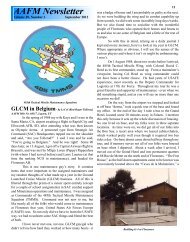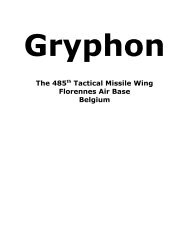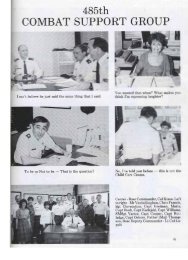The Short, Happy Life of the Glick-Em - Air Force Magazine
The Short, Happy Life of the Glick-Em - Air Force Magazine
The Short, Happy Life of the Glick-Em - Air Force Magazine
- No tags were found...
You also want an ePaper? Increase the reach of your titles
YUMPU automatically turns print PDFs into web optimized ePapers that Google loves.
viet SS-20 because <strong>the</strong> GLCM and<strong>the</strong> Pershing II had distinctive,complementary characteristics.<strong>The</strong> new Pershing was a followonto <strong>the</strong> existing, shorter rangePershing IA. As a ballistic missile, it<strong>of</strong>fered a high assurance <strong>of</strong> penetratingany Soviet defenses. Its speedenabled it to threaten time-sensitivetargets. It was designed to take advantage<strong>of</strong> <strong>the</strong> existing Pershing IAinfrastructure in Europe.<strong>The</strong> smaller GLCMs were projectedto have lower life-cycle costs.<strong>The</strong>ir longer range—1,550 miles—allowed <strong>the</strong>m to be based far<strong>the</strong>rfrom <strong>the</strong> front lines. This increased<strong>the</strong>ir survivability and—not incidentally—allowedmore allied nationsto accept deployments on <strong>the</strong>ir territory.As Brown put it: “<strong>The</strong> deployment<strong>of</strong> a mixed ballistic/cruise missileforce hedges against <strong>the</strong> failure<strong>of</strong> one type <strong>of</strong> system, provides <strong>the</strong>flexibility to select <strong>the</strong> best weaponfor a given mission, and greatly complicatesenemy planning.”Naval Origins<strong>The</strong> <strong>Air</strong> <strong>Force</strong>’s BGM-109G GLCM,nicknamed Gryphon, did not beginlife as an <strong>Air</strong> <strong>Force</strong> system. It was amodified version <strong>of</strong> <strong>the</strong> Navy’s Tomahawksea launched cruise missile.Development began in 1977.Because <strong>of</strong> <strong>the</strong> political need for<strong>the</strong> system, <strong>the</strong> GLCM passed rapidlyfrom concept through development,but its progress was not alwayssmooth. Engineers found that<strong>the</strong>y needed to do much more thansimply slap a Tomahawk on a trailerand hand <strong>the</strong> driver a portable radio.Development <strong>of</strong> <strong>the</strong> TransporterErector Launcher and associated infrastructuresuch as <strong>the</strong> launch controlcenter was a task that proved tobe far more complicated than firstimagined. Crashes <strong>of</strong> test vehiclesalso caused <strong>the</strong> Joint Cruise MissilesProject Office to decertify <strong>the</strong> missileon two occasions.<strong>The</strong> finished production missilewas almost 21 feet long, with itsstubby wings stretching out to aboutnine feet. Top speed was just underMach 1. <strong>The</strong> Convair Division <strong>of</strong>General Dynamics was <strong>the</strong> primecontractor. McDonnell Douglas made<strong>the</strong> guidance system, and WilliamsInternational/Teledyne provided <strong>the</strong>small F107 turb<strong>of</strong>an power plantGLCMs were stored in protectivealuminum canisters with <strong>the</strong>ir wings,control fins, and engine inlets retracted.In a crisis, <strong>the</strong> canisters wouldbe loaded onto Transporter ErectorLaunchers—giant 78,000-pound tractortrailers. <strong>The</strong> TELs and <strong>the</strong>ir supportvehicles would be deployed tosecret, presurveyed launch sites inremote areas <strong>of</strong> <strong>the</strong> host country.Coordinates for <strong>the</strong> launch location,along with wea<strong>the</strong>r information, were<strong>the</strong>n to be entered in <strong>the</strong> missile’sflight computer. Two launch <strong>of</strong>ficerswould have taken 20 minutes to en-USAF photo by TSgt. Bill ThompsonIn a crisis, <strong>the</strong> GLCM system would be deployed to secret, presurveyed launchsites. At top, a camouflaged GLCM unit was hard to spot. Here, a GLCM wasfired during a test launch in <strong>the</strong> US.72ter launch codes received by satellite.Once authorized, <strong>the</strong> <strong>of</strong>ficerswould have simultaneously pressed“execute” buttons.GLCMs were blasted out <strong>of</strong> <strong>the</strong>irlaunch tubes by a solid-fuel rocketbooster. Once clear <strong>of</strong> <strong>the</strong> canister,<strong>the</strong> booster was jettisoned and <strong>the</strong>missile’s wings, control fins, andengine inlet would snap into place.<strong>The</strong> turb<strong>of</strong>an engine <strong>the</strong>n took overand powered <strong>the</strong> missile on a precise,preprogrammed route to a targethundreds <strong>of</strong> miles away.<strong>The</strong> GLCM was intended to overflyfriendly nations at high altitudesto save fuel. Approaching hostileterritory, it would <strong>the</strong>n drop to analtitude <strong>of</strong> about 50 feet above groundlevel and its terrain-following guidancesystem would steer it toward itstarget. On final approach it wouldswoop upward to avoid any physicalAIR FORCE <strong>Magazine</strong> / July 2002
USAF photo by MSgt. Jose Lopez Jr.<strong>The</strong> INF treaty called for destruction <strong>of</strong> all but eight display articles. Here, atDavis–Monthan AFB, Ariz., a circular saw cuts through <strong>the</strong> door <strong>of</strong> a GLCMtransport–launch vehicle.Pershing IIs were at best redundantand at worst provocative. <strong>The</strong>y rejected<strong>the</strong> whole idea <strong>of</strong> “linking”US and Western Europe toge<strong>the</strong>r viaplacement <strong>of</strong> new INF systems onEuropean soil.<strong>The</strong> leading proponent <strong>of</strong> this viewwas Paul Warnke, <strong>the</strong> dovish director<strong>of</strong> <strong>the</strong> Arms Control and DisarmamentAgency in <strong>the</strong> Carter Administration.“<strong>The</strong>re is no military justification”for cruise missile deployment,Warnke wrote in an op–ed article in<strong>the</strong> Washington Post. “<strong>The</strong> potentialtargets for <strong>the</strong>se missiles are alreadycovered by ballistic missiles.”Warnke was enthusiastic aboutdepriving <strong>the</strong> US <strong>of</strong> nuclear weapons.He urged <strong>the</strong> Reagan Administrationto quickly strike an arms dealthat would halt <strong>the</strong> deployment <strong>of</strong><strong>the</strong> American GLCMs and PershingIIs in return only for a reduction—not <strong>the</strong> elimination—<strong>of</strong> <strong>the</strong> SovietSS-20 force. Warnke opined that,without progress on arms control,“<strong>The</strong> United States will face a fur<strong>the</strong>rdeterioration in its relations with<strong>the</strong> Soviet Union, and WesternEurope’s confidence in Americanleadership will decline.”In <strong>the</strong> end, <strong>of</strong> course, Reagan declinedto take Warnke’s advice. FormalINF talks between <strong>the</strong> US and<strong>the</strong> USSR began in 1981 but didn’treally get serious until <strong>the</strong> majordeployments began. <strong>The</strong> US positionwas a simple one: “zero–zero”—elimination <strong>of</strong> <strong>the</strong> new longer-rangeINF systems in Europe by both sides.Moscow, for its part, proposed alimit <strong>of</strong> 300 missiles and nuclearcapableaircraft, with British andFrench nuclear systems counting towardNATO’s quota.Soviet WalkoutAt <strong>the</strong> time, GLCM deploymentshad not yet begun, and with <strong>the</strong>power <strong>of</strong> <strong>the</strong> anti-nuclear movementstill building, <strong>the</strong> Soviets must havethought time was on <strong>the</strong>ir side. ButNATO hung toge<strong>the</strong>r. After additionalUS systems began arriving inEurope in late 1983, <strong>the</strong> USSRwalked out <strong>of</strong> <strong>the</strong> talks. No negotiationstook place in 1984.Eventually, Moscow blinked andagreed to come back to <strong>the</strong> negotiatingtable. In January 1985, Secretary<strong>of</strong> State George P. Shultz and SovietForeign Minister Andrei Gromykoagreed to parallel talks on INF, strategicforces, and defense and spaceissues. That fall, Moscow hinted thatit wanted an INF treaty separate from<strong>the</strong> o<strong>the</strong>r negotiating tracks. Sovietnegotiators <strong>of</strong>fered a proposal thatwould have allowed NATO to keepsome GLCMs—but which still wouldhave permitted SS-20 warheads equalto GLCM and British and Frenchforces combined. This was clearlyunacceptable to <strong>the</strong> West.<strong>The</strong>n <strong>the</strong> pace <strong>of</strong> events began toaccelerate. High-level discussionstook place in 1986, capped by <strong>the</strong>confusion caused by <strong>the</strong> October 1986summit between Reagan and Sovietleader Mikhail Gorbachev in Reykjavik,Iceland.In February 1987, <strong>the</strong> Soviet Unionannounced that it was ready to workan INF deal detached from all o<strong>the</strong>rnuclear issues. That July, Gorbachevagreed to <strong>the</strong> original US zero–zeroposition. He also agreed to <strong>the</strong>n unprecedentedverification protocols,including on-site monitoring <strong>of</strong> INFproduction facilities.<strong>The</strong> political context <strong>of</strong> <strong>the</strong> INFaccords will be a subject <strong>of</strong> historicalinquiry for years to come. Deterioratinginternal conditions in <strong>the</strong>USSR clearly played a part in Sovietdecisions. Perhaps Reagan’s determinationto pump billions into strategicdefense technology contributed,too.<strong>The</strong> agreement also validatedNATO’s original two-track responseto <strong>the</strong> advent <strong>of</strong> <strong>the</strong> SS-20. <strong>The</strong> deployment<strong>of</strong> GLCMs and PershingIIs demonstrated in a convincingmanner <strong>the</strong> depth <strong>of</strong> <strong>the</strong> US commitmentto European security and <strong>the</strong>strength <strong>of</strong> alliance solidarity.<strong>The</strong> two sides signed <strong>the</strong> INF treatyin 1987, and soon <strong>the</strong>reafter <strong>the</strong> <strong>Air</strong><strong>Force</strong> began withdrawing its GLCMsfrom Europe. By May 1991, all weregone, sawed up into expensive scrap.All, that is, except for <strong>the</strong> eight displayarticles permitted under terms<strong>of</strong> <strong>the</strong> treaty. <strong>The</strong> US <strong>Air</strong> <strong>Force</strong> Museumat Wright–Patterson AFB, Ohio,has <strong>the</strong> first <strong>of</strong> <strong>the</strong> Gryphons thatwent on alert at Greenham Common.<strong>The</strong> Ground Launched Cruise MissileHistorical Foundation dedicateda second display article this springat <strong>the</strong> Pima <strong>Air</strong> and Space Museumin Tucson, Ariz.Eventually <strong>the</strong> GLCM foundationhopes to have a full display reflectingall <strong>the</strong> capabilities <strong>of</strong> a squadron,including launch facilities andsecurity forces.“We knew all along we were politicalpawns,” said Livingston, whoserves as president <strong>of</strong> <strong>the</strong> foundation.“Everybody knew <strong>the</strong> importance<strong>of</strong> what we were doing. Thatpride has carried over to today.” ■Peter Grier, a Washington, D.C., editor for <strong>the</strong> Christian Science Monitor, is alongtime defense correspondent and a contributing editor to <strong>Air</strong> <strong>Force</strong><strong>Magazine</strong>. His most recent article, “Meltdown <strong>of</strong> <strong>the</strong> Nuclear Critics,” appearedin <strong>the</strong> June 2002 issue.74AIR FORCE <strong>Magazine</strong> / July 2002










